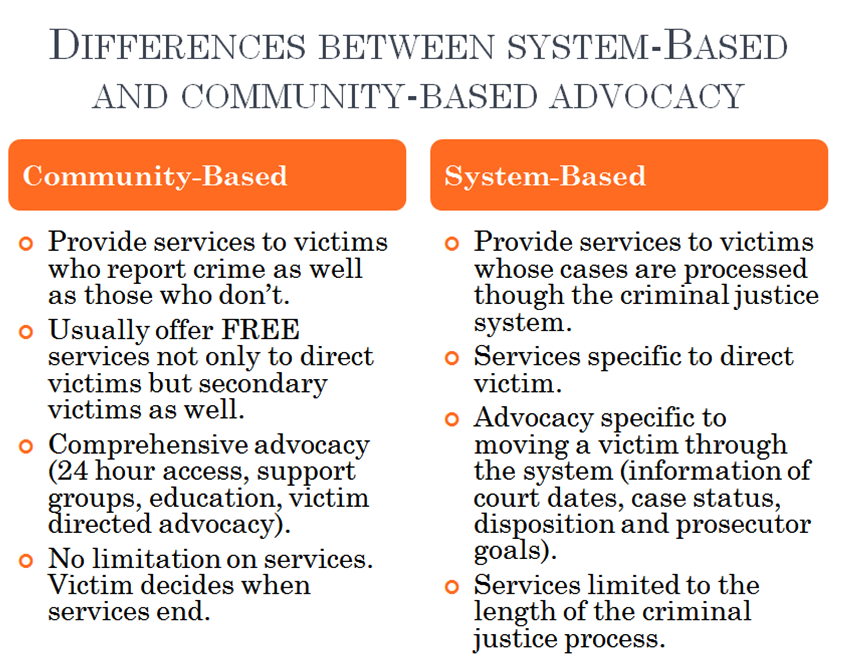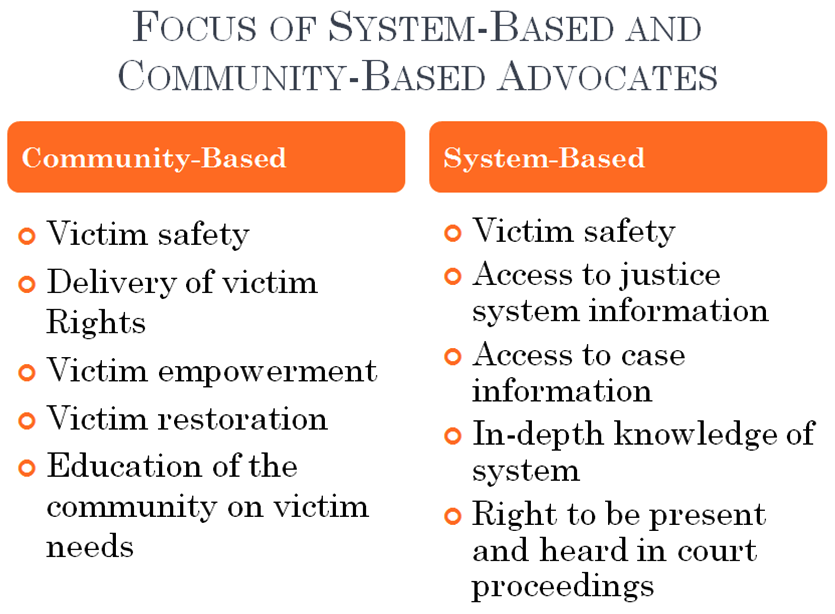System-Based and Community Based Advocacy – The Need for Both
Many agencies around the country employ victim advocates within their own departments. Such agencies include police departments, prosecutor offices and Department of Corrections. Many victims are not aware that there are victim advocates within the community as well. Many times I have heard why does a victim need an advocate from the community if they already have one in the system? The reason is that advocates in police departments, prosecutor offices and Department of Corrections serve a different role than victim advocates in the community. To understand the need for both types of advocacy, we need to have a basic idea of how System-Based and Community-Based advocates differ and how they are the same.
System-Based advocates and Community-Based advocates can be differentiated by where the advocate is employed, who they are responsible to and sometimes the nature of their duties. System-Based advocates are typically employed by a criminal justice agency, serve as the primary contact for victims with that particular agency and facilitate the victim’s participation in the justice process.
Community-Based advocates are individuals who work in an independent, usually non-profit organization. They provide comprehensive services to victims, regardless of whether they choose to report the crime and participate in the criminal justice process. Community-Based advocates also provide services before, during and after a criminal case. Services are also available when there is no criminal case at all.
The focus of System-Based advocacy and Community-Based advocacy also differ.
Additional differences between the two types of advocacy are crimes types served. System-Based advocates predominately serve victims of violent crime. Community-Based advocates, such as Victim Support Services, serve a variety of crime types. Community-Based agencies also focus largely on education and awareness and providing opportunities to gather with other victims of crime through support groups, social events and crime related events throughout the year.
System-Based and Community-Based advocates/advocacy roles are different. The need for both types of advocacy is essential because victims will not get the full, wrap around help that is needed to get back to a new normal. For more information regarding how System-Based and Community-Based advocates’ roles are different, and how we work together, please call 1-800-346-7555.
Sources
U.S. Department of Justice. “The Role of Victim and Victim Advocate in Managing Sex Offenders”. http://www.csom.org/train/victim/3/3_3.htm
Lonsway, Dr. Kimberly A. “The Role of Victim Advocates”. National Center for Women and Policing, Violence Against Women Office and Office of Justice Programs. http://www.mincava.umn.edu/documents/acquaintsa/trainer/victimadvocate.doc
Center for Sex Offender Management (2000). “Comparing Community-Based and System-Based Advocates”. http://www.csom.org/train/victim/3/material/Section%203%20Handout%20-%20Comparing%20Advocates.pdf
Helton, Peggy & Lisa Maling. “Defining Advocacy”. Sexual Assault Prevention and Crisis Services; Crime Victim Services Division of Attorney General’s Office of Texas. http://www.taasa.org/wp-content/uploads/2012/04/Defining-Advocacy1.ppt
King County Coalition Against Domestice Violence (2007). “FAQ’s for Defense Attorneys. Community-Based Domestic Violence Advocates: A Resource for Battered Women Charged with Crimes”. http://www.kccadv.org/wp-content/uploads/2011/04/FAQs-Defense-re-CommunityAdvocacy1.pdf


